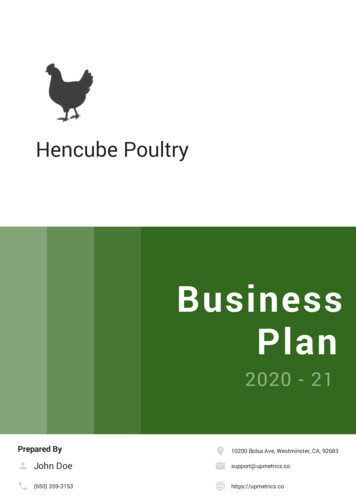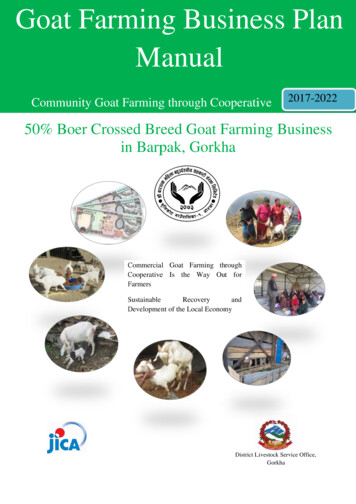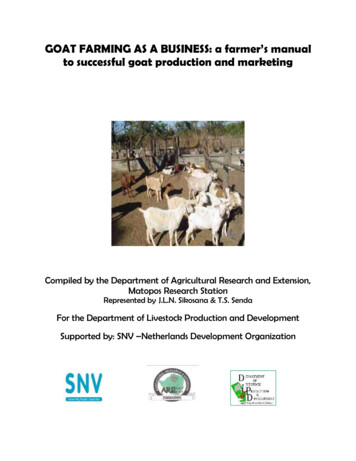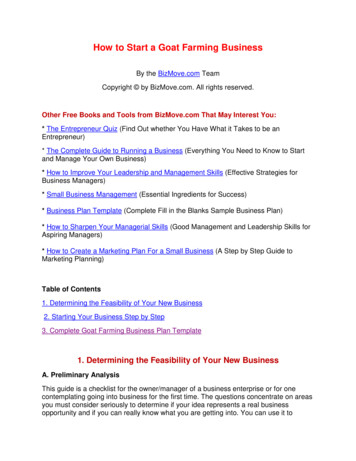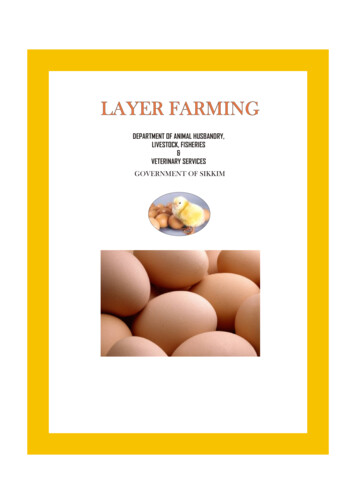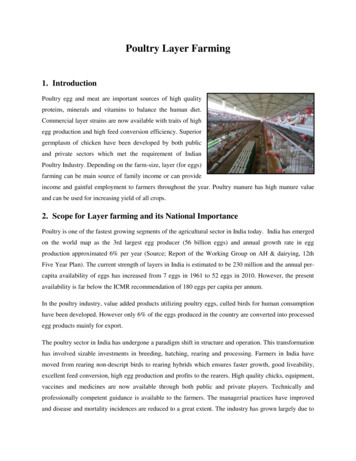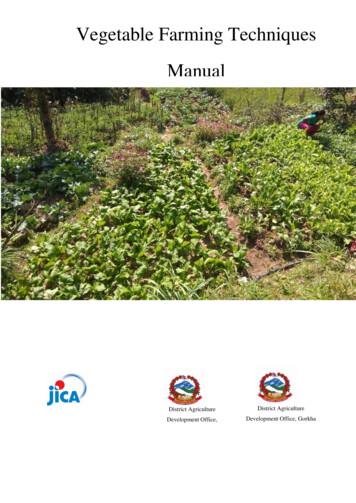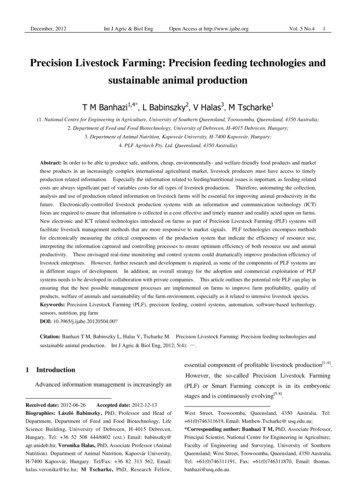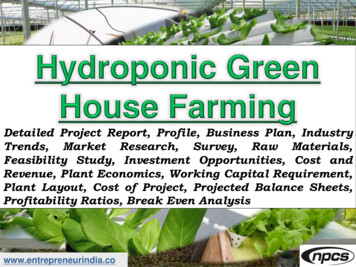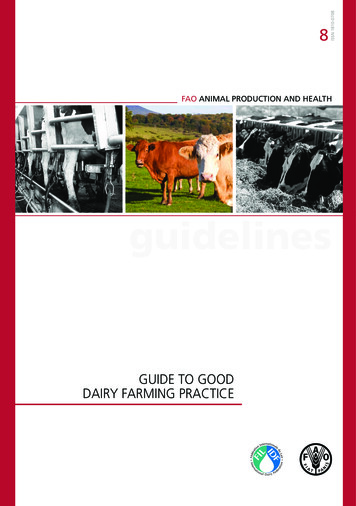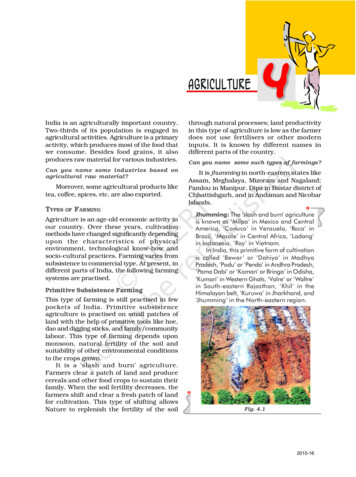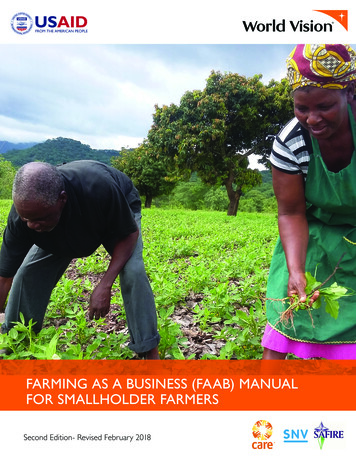
Transcription
FARMING AS A BUSINESS (FAAB) MANUALFOR SMALLHOLDER FARMERSSecond Edition- Revised February 2018
Farming as a Business (FaaB) Manual for Smallholder farmers.AcknowledgementsThis manual is the second edition of “Farming as a Business (FaaB) Manual for Smallholder farmers.The second edition of the manual builds on the first edition developed by SNV in 2014. Original technical content,photographs and expertise for the manual were provided by the ENSURE Livelihoods and Economic DevelopmentTechnical Team.The production of this manual was made possible through the generous support of the American people through theUnited States Agency for International Development (USAID). The contents of this report are the responsibility of theWorld Vision-led ENSURE food security program and do not necessarily reflect the views of USAID or the United StatesGovernment.Editing and Revision: Philip Goredema, Alex Popi, Honoured Moyo, Patson Makwiramiti, Abraham Muzulu. Authur Masuka, JaneZimbiruFunded By: USAID.Published by ENSURE, February 2018 World Vision, 2019This publication may be freely reproduced for non-profit purposes.2
Farming as a Business (FaaB) Manual for Smallholder farmers.Table of ContentsBackground.5MODULE 1. Creating a Commercial Farming Mindset .61.1 What Makes up your Farm Business?.61.2 How do you Explain the Following Changes in Farming Practices?.61.3 The Farm Business Cycle.71.4 Explaining the Business Cycle using Nyere’s Story.71.5 Characteristics of a Business Person . 121.6 Important aspects of a farm business. 13MODULE 2. Overview of Farm Record Keeping. 142.1 What is a Record?. 142.2 Why Keep Records?. 142.3 Advantages of Record Keeping. 142.4 Consequences of Keeping Poor Records. 142.5 Types of Farm Business Records. 15MODULE 3 Farm Enterprise Budgeting. 183.1 Introduction to Farm Budgeting?. 183.2 What is Farm Budgeting?. 183.3 Components of a Budget. 183.4 The Process of Budgeting. 183.5 Working Example: Prepare a budget!.203.6 Examples of Enterprise Budgets.203.7 Determining the Minimum Price and Yield for the Enterprise.23MODULE 4 Marketing and the Markets. 244.1 The Concept of Marketing. 244.2 Definitions. 244.3 Learning Points from Various Definitions. 244.4 Agricultural Marketing.263
Farming as a Business (FaaB) Manual for Smallholder farmers.4.5 Characteristics of Agricultural commodities.264.6 Role of Marketing.274.7 Types of Markets.274.8 Elements of Marketing.304.9 Marketing Constraints and Solutions. 314.9.1 Different Stages in Marketing Produce.324.9.2 Together Each Achieves More. 334.9.3 Assessing Group Selling/Buying.344.9.4 Market Survey Questionnaire.35ANNEXES . 434
Farming as a Business (FaaB) Manual for Smallholder farmers.BackgroundThe ENSURE (Enhancing Nutrition Stepping Up Resiliency and Enterprise) Program is a USAID-funded projectimplemented in Masvingo and Manicaland Provinces with the goal of improving household food security.Purpose of this training initiativeThe main goal of this training manual is to promote farming as a family business for viable and sustainable food andnutritional security. This is done through imparting skills on commercial business mindset, record keeping, enterprisebudgeting, and marketing. The manual will help farmers to learn and improve their business knowledge, attitude and skills.Targeted participants need to be basically literate and numerate, but not necessarily formally educated, to use this manual.In order to make more money from farming, farmers must take advantage of new opportunities, adapt their farmingbusinesses to market changes, and improve efficiency and profitability.The desire to increase income by taking advantage of market opportunities requires farmers to become better decisionmakers and better at competing in this new environment. The emphasis on the market and the need for farmers to becompetitive calls for better farm management skills. Farm management knowledge and skills help farmers to make the rightchoice between farm enterprises.5
Farming as a Business (FaaB) Manual for Smallholder farmers.MODULE 1. Creating a commercial farming mindsetThis module is designed to:i.Facilitate a smooth transition from subsistence farming towards commercial farmingii.Enhance an understanding of the nature of the farming business.iii.Facilitate an understanding of a farm business cycle.1.1 What makes up your farm business? (Brainstorm and present in a plenary discussion)1.2 How do you explain the following changes in farming practices? (Ask the participants to explain the changes)Farming for FoodFarming for CashWhy This Change30 years ago10 years agoToday6
Farming as a Business (FaaB) Manual for Smallholder farmers.1.3 The farm business cycle (Explain the business cycle to the participants)Diagnosis tionMarketingMonitoringProducingOrganising1.4 Explaining the business cycle using Nyere’s storyPart 1: Diagnosis/finding opportunitiesAfter completing his secondary education, Nyere had left his village to seek a job in the city. While the city life had beenexciting and he had found several work opportunities, it had also been a hard living. Nyere’s father was now too old to bemanaging the one acre family irrigation plot by himself, and Nyere was now happy to return home. However, he wantedto make sure that he would be earning enough to support his family on a long-term basis. For this, he needed to knowthe current farming practices and see what could be done to raise the income generated by the land. Upon return, Nyerestarted talking to the farmers in his own village, so that he could find out what crops were being grown in the area. Herealized that most farmers were growing the same crops: beans, onions, and maize. When asked why, they said becauseeveryone else did; it was what they had always grown. He also learned that these farmers were selling their produce to thefirst buyer who came to the farm.As a next step, Nyere decided to find out other products could be produced in the area. He went to the nearest townwhere he talked to shopkeepers and traders, and found out that there was a high demand for garlic. Nyere knew thatgrowing garlic was like growing onions, so it would not be difficult to produce. He also found three shopkeepers whosaid that they would buy garlic from him, provided it was of good quality. They said they normally paid 3 per kg. Beforeinvesting in garlic production, Nyere realized that he needed to know if he could make a profit by growing and selling garlicat the market rate. He visited a neighbouring village, where farmers helped him calculate how profitable garlic was.7
Farming as a Business (FaaB) Manual for Smallholder farmers.As a final step, Nyere approached a local extension worker who advised him to start garlic production by planting ¼ anacre with the new crop. The extension worker told him he should be able to harvest about 750 kg to 1000 kg per acre,so on ¼ acre, he should be able to produce between 190 and 250 kg of garlic. After completing his investigations, Nyeredecided to grow garlic on ¼ acre of his farm and plant beans, onions and maize on the rest of the land.Probing questions:What did Nyere realise about the farmers in his village?What did Nyere decide to do?H
Farming as a Business (FaaB) Manual for Smallholder farmers. MODULE 1. Creating a commercial farming mindset This module is designed to: i. Facilitate a smooth transition from subsistence farming towards commercial farming ii. Enhance an understanding of the nature of the farming business. iii. Facilitate an understanding of a farm business cycle.
